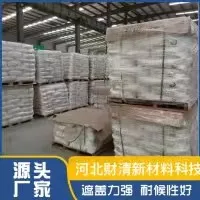
मई . 22, 2025 09:28 सूची पर वापस जाएं
The Role of Titanium Dioxide in Coated Paper Manufacturing
रंजातु डाइऑक्साइड (TiO₂) is a highly versatile and widely utilized inorganic compound known for its exceptional opacity, brightness, and UV resistance. In the coated paper manufacturing industry, titanium dioxide powder serves as a critical pigment that enhances the visual and functional properties of paper products. Coated paper, used extensively in high-end printing, packaging, and publishing, relies on titanium dioxide coatings to achieve superior whiteness, smoothness, and printability.

The demand for high-performance coated papers has led to an increased reliance on titanium dioxide pigment, sourced from specialized titanium dioxide powder suppliers. This article explores the multifaceted role of TiO₂ in coated paper production, detailing its contributions to opacity, print quality, durability, and sustainability.
रंजातु डाइऑक्साइड Powder: Key Properties for Paper Coating Applications
The effectiveness of titanium dioxide in coated paper manufacturing stems from its unique physicochemical properties.
1. High Refractive Index and Light-Scattering Efficiency
रंजातु डाइऑक्साइड possesses one of the highest refractive indices among white pigments—approximately 2.7 for the rutile form and 2.55 for anatase. This property allows titanium dioxide powder to scatter light efficiently, providing unmatched opacity in thin paper coatings. Unlike other fillers such as calcium carbonate or kaolin clay, TiO₂ requires minimal quantities to achieve the desired opacity, reducing the overall coating weight while maintaining performance.
2. Superior Whiteness and Brightness Enhancement
The inherent whiteness of titanium dioxide pigment ensures that coated papers exhibit a neutral, bright appearance, which is crucial for high-quality printing. Unlike organic whiteners that may degrade over time, TiO₂ maintains its brightness even under prolonged exposure to light, making it ideal for archival papers and premium packaging.
3. UV Absorption and Photostability
One of the critical challenges in paper manufacturing is preventing yellowing and degradation caused by UV radiation. रंजातु डाइऑक्साइड coatings act as a protective barrier, absorbing harmful UV rays and preventing photochemical degradation of cellulose fibers. This property is particularly beneficial for outdoor packaging, labels, and high-end art prints that require long-term durability.
4. Chemical Inertness and Compatibility with Coating Formulations
TiO₂ is chemically stable, resisting reactions with acids, alkalis, and other components in paper coatings. This inertness ensures that titanium dioxide paint and coating formulations remain consistent during production, preventing unwanted interactions that could affect paper quality.
The Role of रंजातु डाइऑक्साइड in Coated Paper Manufacturing Processes
The application of titanium dioxide in coated paper involves several critical stages, from slurry preparation to final calendering.
1. Coating Formulation and Slurry Preparation
In the initial stage, titanium dioxide powder is dispersed in a liquid medium along with binders (e.g., latex or starch) and other additives to form a homogeneous coating slurry. The selection of high-quality titanium dioxide pigment from reputable titanium dioxide powder suppliers is essential to ensure uniform dispersion and optimal rheological properties.
2. Application of रंजातु डाइऑक्साइड Coating on Paper Substrate
The coating slurry is applied to the base paper using blade coaters, air-knife coaters, or rod applicators. The titanium dioxide coating forms a smooth, uniform layer that enhances surface properties such as gloss, ink receptivity, and tactile feel. The high opacity of TiO₂ allows for thinner coatings, reducing material costs without compromising performance.
3. Drying and Calendering for Enhanced Finish
After application, the coated paper undergoes drying to remove moisture, followed by calendering—a high-pressure polishing process that enhances smoothness and gloss. The presence of titanium dioxide in the coating ensures that the paper retains its brightness and opacity even after mechanical treatment.
Future Trends and Sustainable Alternatives in रंजातु डाइऑक्साइड प्रयोग
While titanium dioxide remains irreplaceable in many applications, the industry is exploring sustainable practices to reduce reliance on virgin TiO₂.
1. Recycling and Recovery of रंजातु डाइऑक्साइड from Waste Coatings
Emerging technologies aim to recover TiO₂ from deinked paper sludge, reducing waste and lowering production costs.
2. Hybrid Coatings with Partial TiO₂ Replacement
Some manufacturers blend titanium dioxide pigment with alternative opacifiers (e.g., hollow plastic pigments) to maintain performance while reducing TiO₂ content.
3. Advances in Coating Technologies for Reduced Consumption
Nano-engineered titanium dioxide coatings and optimized application methods are being developed to maximize opacity with minimal material usage.
-
Application of Titanium Dioxide 2195 in Water Purification
समाचारNov.14,2025
-
What are the global market trends of Titanox titanium dioxide in recent years
समाचारNov.14,2025
-
Effect of particle size distribution on the optical properties of R996 TiO2
समाचारNov.14,2025
-
Latest Technological Innovations in Rutile Titanium Dioxide Manufacturing
समाचारNov.14,2025
-
Compatibility of Titanium Dioxide Concrete Pigment with Different Concrete Admixtures
समाचारNov.14,2025
-
Environmental Impact of Titanium Dioxide Pigment Manufacturing and Mitigation Measures
समाचारNov.14,2025
